The Australian economy at a crossroads
The Australian economy finds itself in an interesting position, characterized by a mixture of softening activity indicators and a remarkably tight labour market.
This situation bears some resemblance to the economic conditions in the United States. However, unlike the US, Australia has not witnessed significant evidence of declining inflation pressures.
Recent concerns regarding wage growth have emerged following the minimum wage decision, leading to a belated hawkish stance from the Reserve Bank of Australia (RBA) and a substantial reassessment by the market of the peak cash rate. Consequently, fears have arisen regarding the potential for the RBA to push the economy towards a tipping point, as it tries to navigate a narrow path between increasing interest rates to fight inflation, without pushing Australia into recession.
Figure 1: Australian inflation slowdown trails US decline
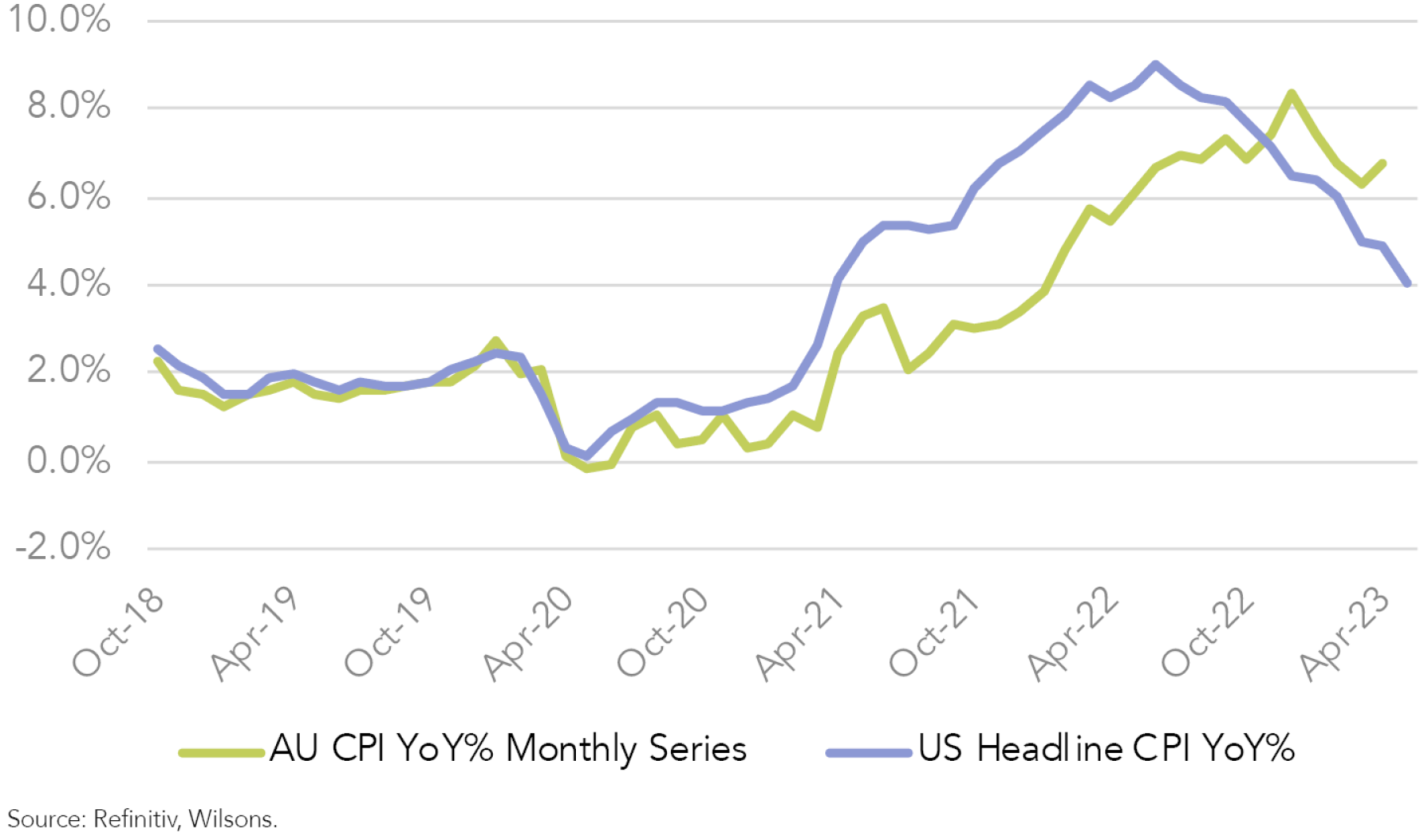
Higher for longer?
The RBA gained significant attention as the first major central bank among developed economies to pause its rate hikes during the April meeting. This move was widely celebrated as a sign that other central banks might follow suit with a pause, to then be followed by rate cuts within months rather than years. However, those hopes diminished when they delivered another 25 basis point (bps) increase during the May meeting.
Against a market leaning towards another pause, the RBA raised the cash rate once again to 4.1% at the recent June meeting, pushing the rate to its highest point since April 2012, while hinting at further potential hikes.
The RBA appears to have become more impatient in waiting for inflation to slow and has de-emphasised the argument about the lagged impact of interest rate hikes, which was the argument used to keep the cash rate steady at the April meeting.
In response to the RBA’s new-found hawkishness, there has been a fairly dramatic repricing of the peak cash rate. In the futures market, the implied year-end rate rose to 4.65% from around 3.40% at the end of Q1 and 3.80% in the middle of May. However, the meeting minutes released last week struck a more dovish tone, revealing the bank considered the arguments for and against hiking were “finely balanced”, which saw expectations for the peak rate fall to 4.5%.
Admittedly, the macro data has been very erratic. But this has not been helped by official guidance, which has not been very consistent.
Figure 2: Dramatic repricing of the expected cash rate took place following the May jobs surge
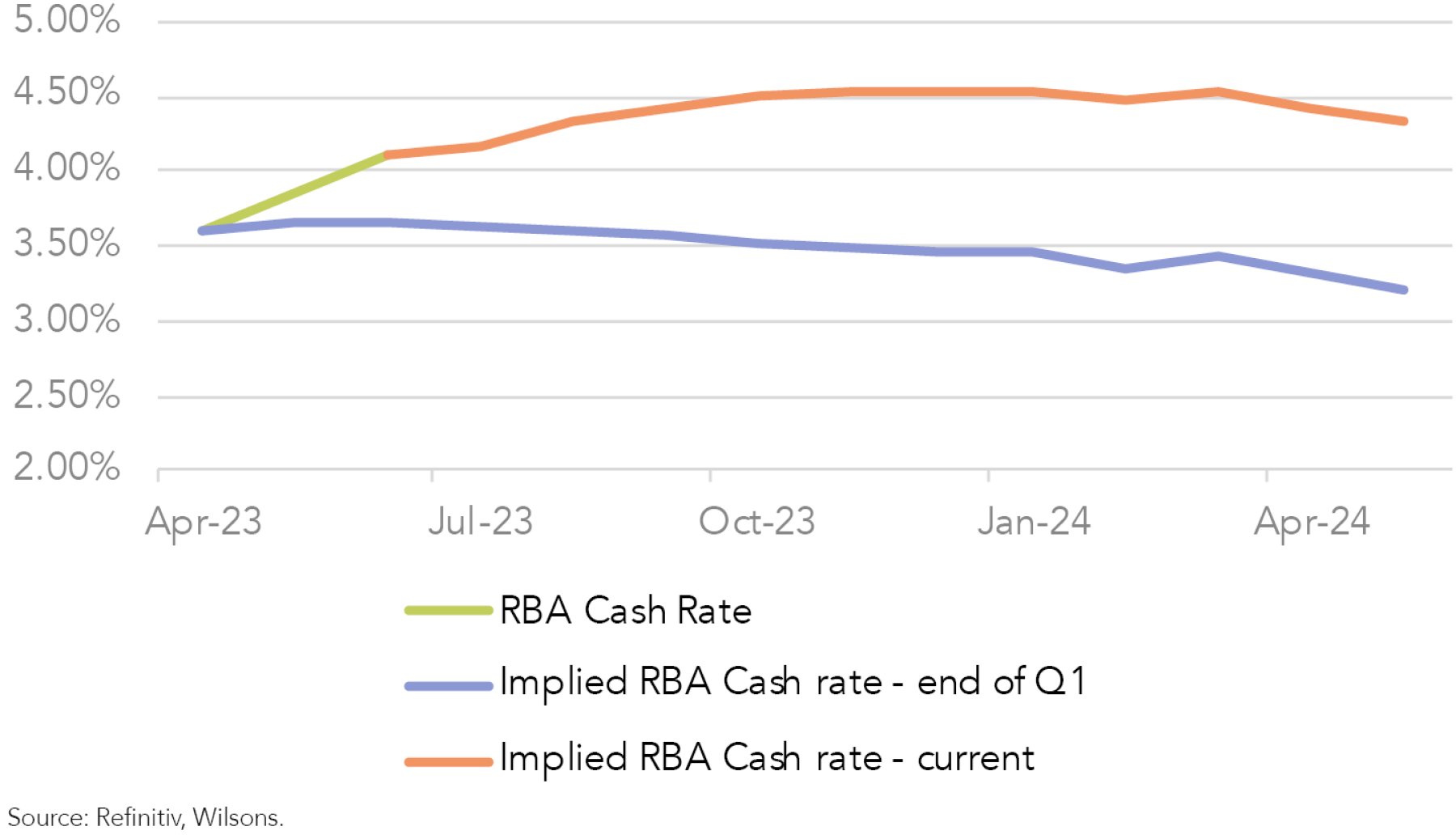
Jobs surge piles pressure on RBA
Most recently, the May labour data strengthened unexpectedly, raising doubts about the slowdown story and putting the RBA back under tightening pressure.
The report showed an increase in employment of 76K, outstripping even the top-of-the-range forecast for a 40K bounce from a small decrease in April. The stronger rebound means we now have average growth of 36K jobs over the two months – around the monthly pace we have seen over the past year, indicating no significant slowing of jobs growth, despite the RBA’s 400 bps of tightening over the same period. This momentum will do nothing to allay the RBA’s concerns that the tight labour market could fuel unsustainable wage and inflationary pressures by compounding the increase in minimum wages of 8.6% (and 5.75% for awards) taking effect from 1 July this year.
Forward-looking indicators of employment growth, including a 20% fall in job ads and a softening in surveyed hiring intentions, signal the jobs market is poised to weaken. But for now, it is the lagging data like employment, wages and inflation driving decision making. This risks a policy mistake of overtightening.
The July meeting remains live on account of labour market strength, while the June jobs report, to be released 20 July, will be a key signpost come the August meeting.
Figure 3: Job ads slowdown suggests labour market should begin to cool
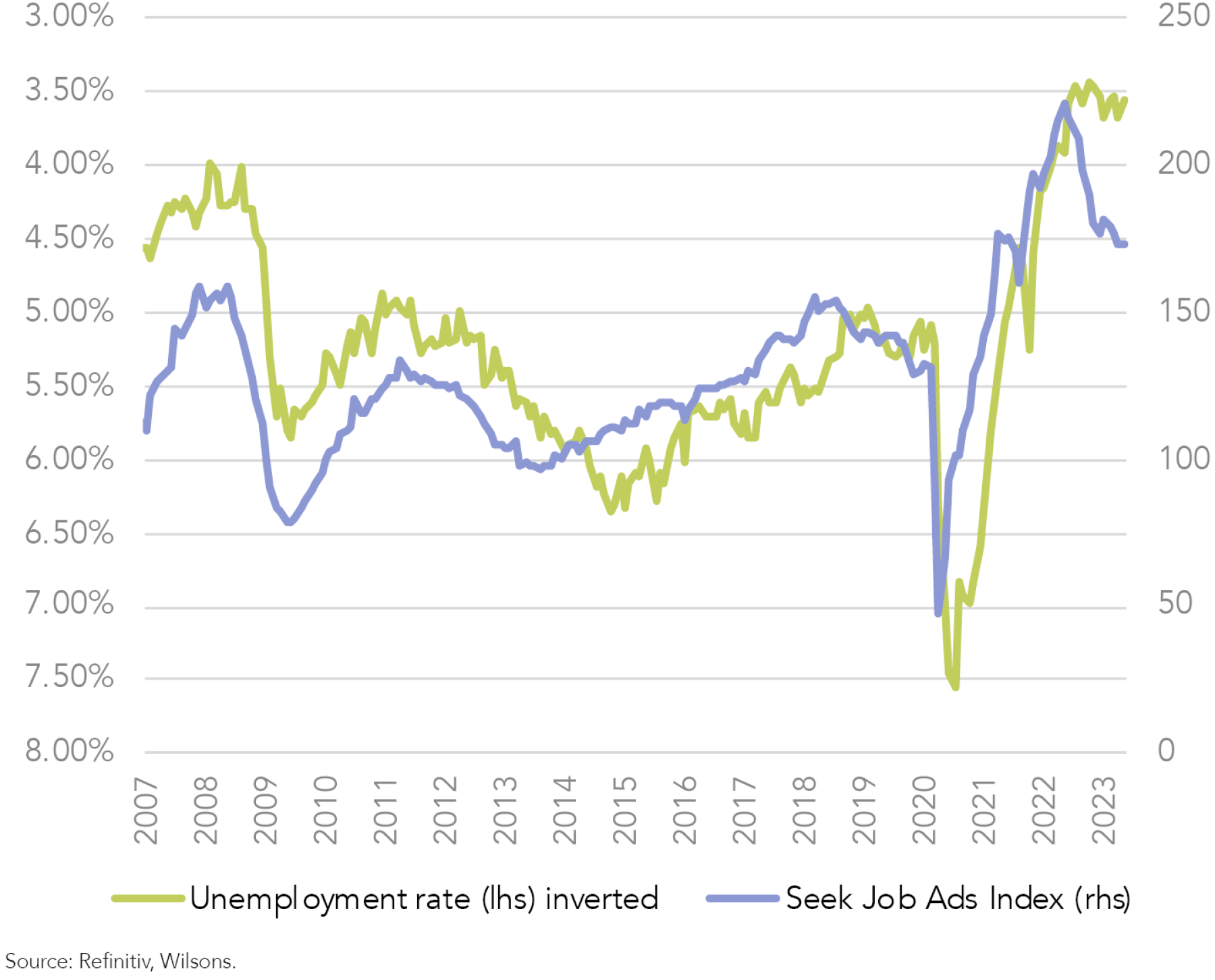
Figure 4: Climbing wages stoke concerns regarding the inflationary pulse
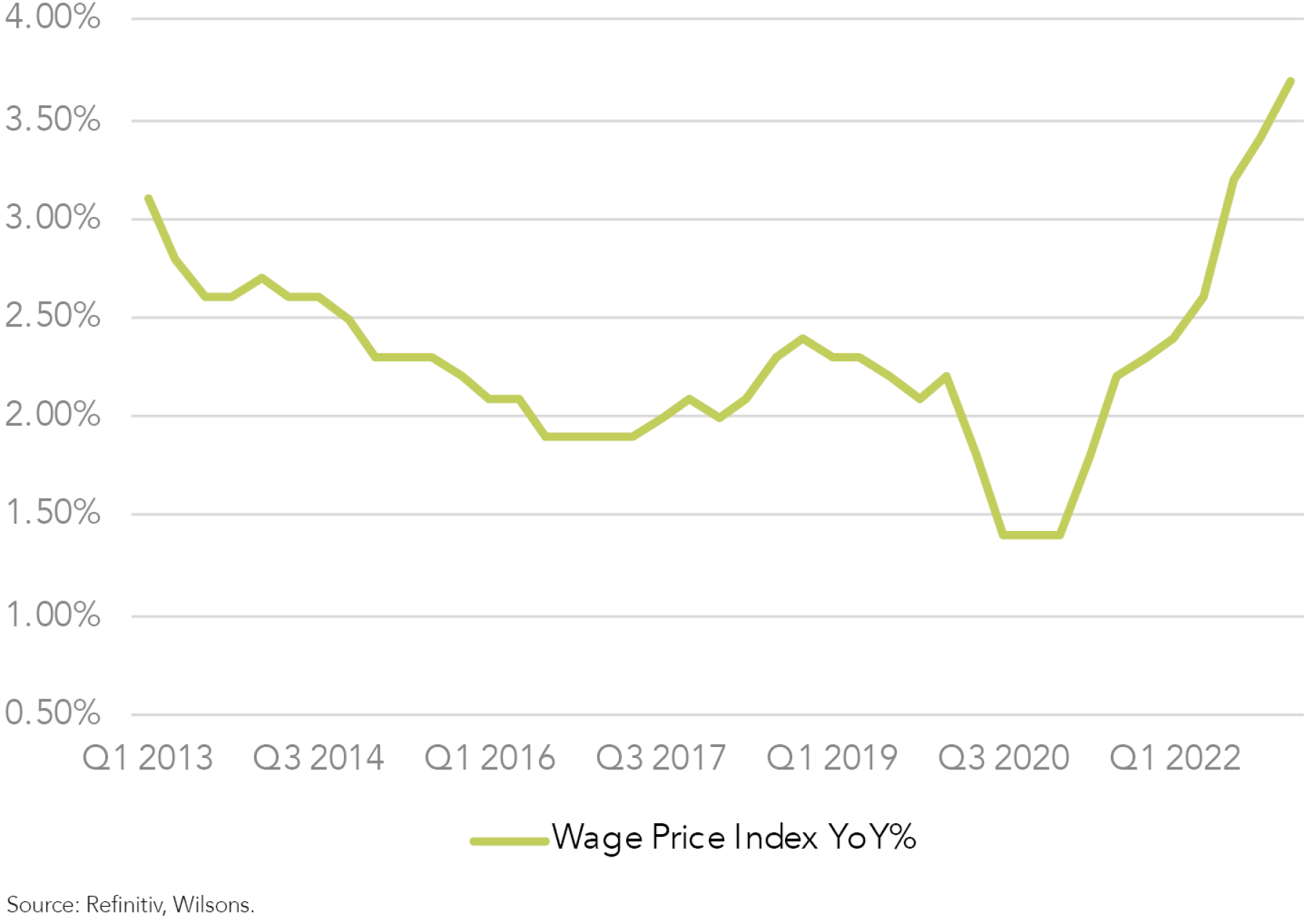
Financial stress on the horizon
Consumer spending prospects, in the face of high inflation and sharply higher interest rates, would be even weaker were it not for the substantial savings buffer that households accumulated during the pandemic and the strong starting point for jobs. Both these supportive variables are likely to gradually wane over the course of the next 12 months but should cushion the extent of the consumer slowdown.
Recent surveys of consumers’ confidence from Westpac and ANZ suggest sentiment remains at or near levels usually seen during periods of economic downturns such the global financial crisis, when Australia dodged a “technical” recession. However, this sentiment has not fully translated into consumer behaviour and actual spending in aggregate. The challenge is that the impact of the rate rises has not hit the economy fully.
Goods spending is beginning to downshift from a very elevated level. In contrast, services spending slumped to depressed levels during the pandemic but has been recovering rapidly of late. So, against a broad trend of a softer consumer we expect the story of a goods spending recession to come sharply into focus in the near term. Services spending will likely take longer to slow, and the slowdown will likely be a lot less dramatic. May retail sales (due 29 June) will be closely watched, especially given listed companies are increasingly reporting that consumption 'fell off a cliff', particularly after the RBA hiked in June.
Figure 5: Peaking expiry of fixed-rate loans signals impending mortgage stress
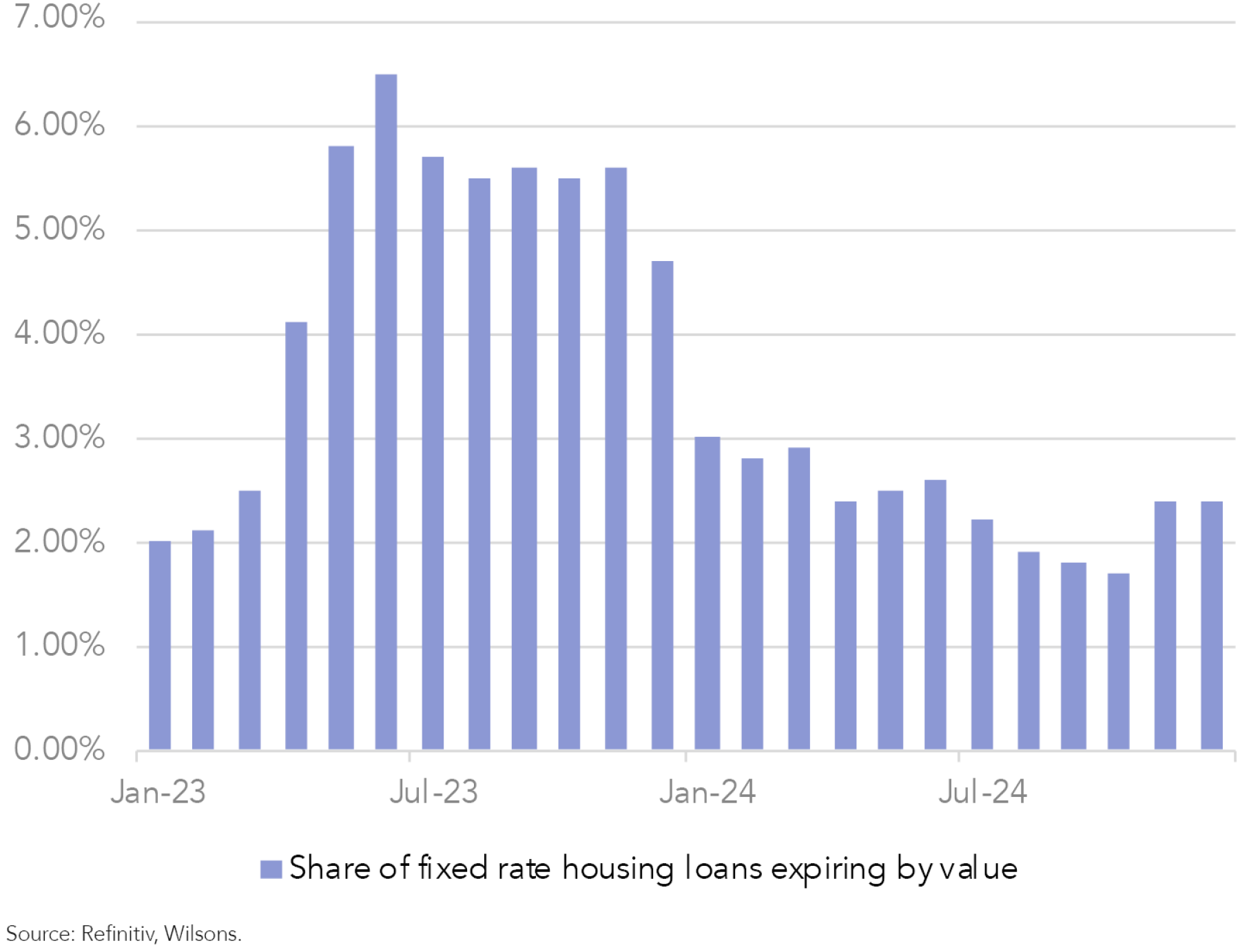
Figure 6: Australia - the outlier with highly geared households
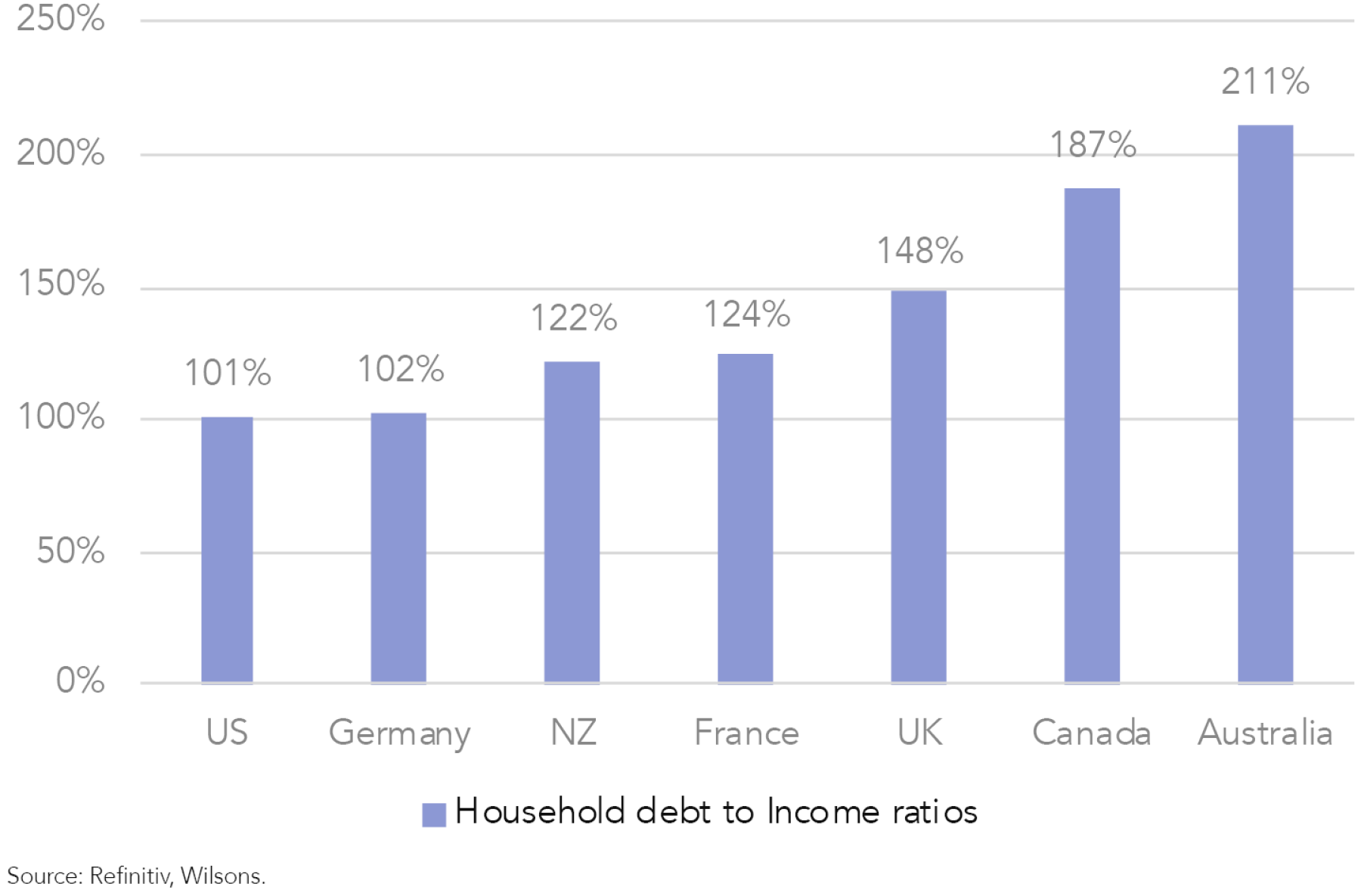
The current peak in fixed-rate home loan expiration suggests an imminent rise in mortgage stress on the horizon. Additionally, it is worth noting that a significant portion (~30%) of fixed-rate loans is still set to transition to much higher floating rates (increases generally from 2% to 5.5–6.0%) in the back half of the year, which will lead to a dampening effect on consumer cash flow, further impacting spending patterns.
With the RBA’s rate increases from May, June, and at least one more hike as currently priced also being passed on, the average mortgage rate over the next year will rise by at least 150 basis points.
Housing – Reversing the trend?
Further complicating the picture is the fact that despite the RBA’s tightening, house prices, which had previously been falling, recorded their third consecutive monthly rise in May. The house price increase seems at odds with sharply lower consumer confidence, and so, for now, our thoughts are that the housing pick-up in the first quarter of 2023 was more of a blip than a definitive turn in prices. Nevertheless, a rapidly rising population, spurred by strong net inward migration as well as low housing supply, could keep house prices and rents under further upward pressure. This area certainly bears close watching. The Corelogic Home Value index released 29 June will be an important data point leading up to the early July RBA meeting.
Our view is that implied market cash rate expectations may be overdone. Our principal argument for a more moderate rate outlook is that we expect to see inflation coming down over the coming months, alongside some likely softening in the employment numbers. Consequently, the pressure for the RBA to keep hiking will lessen substantially - especially as they are not expecting inflation to come down much over the coming quarters, so the hurdle for surprises on the downside is quite a low one.
Still, this is not likely to be plain sailing. What was once mainly a supply-side shock affecting energy and food prices has widened out to a much broader inflationary issue, with virtually all components of the Consumer Price Index (CPI) basket rising at a rate in excess of the RBA's target range, and the annualized run-rate of inflation (currently about 4%) still inconsistent with getting inflation back to trend. The upcoming May monthly inflation report, scheduled for release 28 June, will be closely monitored, especially after April's surprising uptick, which saw a year-on-year (YoY) surge of 6.8%.
While the next monthly print will be closely watched, the RBA will place more emphasis on the more extensive quarterly inflation data, and the upcoming release before the 1 August meeting will undoubtedly be the decisive element influencing the day's outcome.
Figure 7: Three months of positive house price growth breaks a year-long downtrend
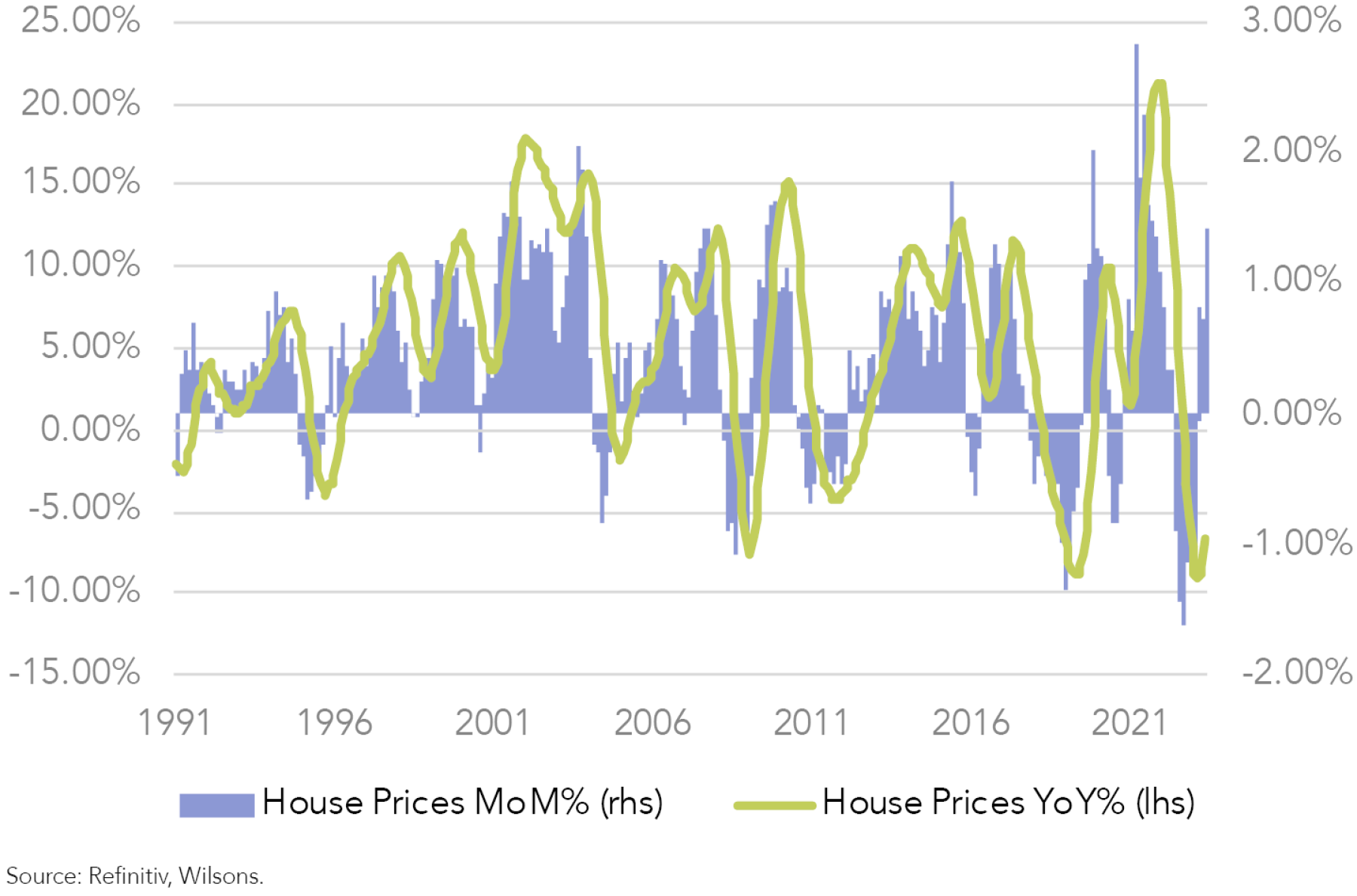
Business confidence rolling over
Businesses are not as downbeat as consumers but business confidence has turned, according to the closely watched NAB business survey. The fall in business conditions now appears to be gathering momentum, and while they remain close to their long-run average, they are well below the levels we saw in early 2023. Forward orders – typically the best measure of economic activity - posted a sharp decline in the past month. If orders persist at these levels, we could well see ongoing sharp falls in business conditions, highlighting the risks around economic growth through the balance of this year.
The consumer-exposed sectors appear to have pulled back the most. Forward orders in both retail and wholesale fell very sharply and are now the weakest of all industries. Historically, there have been very few periods of negative orders outside of downturns in the economy. The business sector may well hold the key in gauging the extent of the economic slowdown, with credit conditions and financial stability likely to be key swing factors in determining the extent of the downturn over and above a softening consumer. Whether a moderating trend continues will be confirmed on 11 July by the next monthly release of the NAB survey.
Figure 8: Forward orders fall below long-run average. Will conditions and confidence follow?
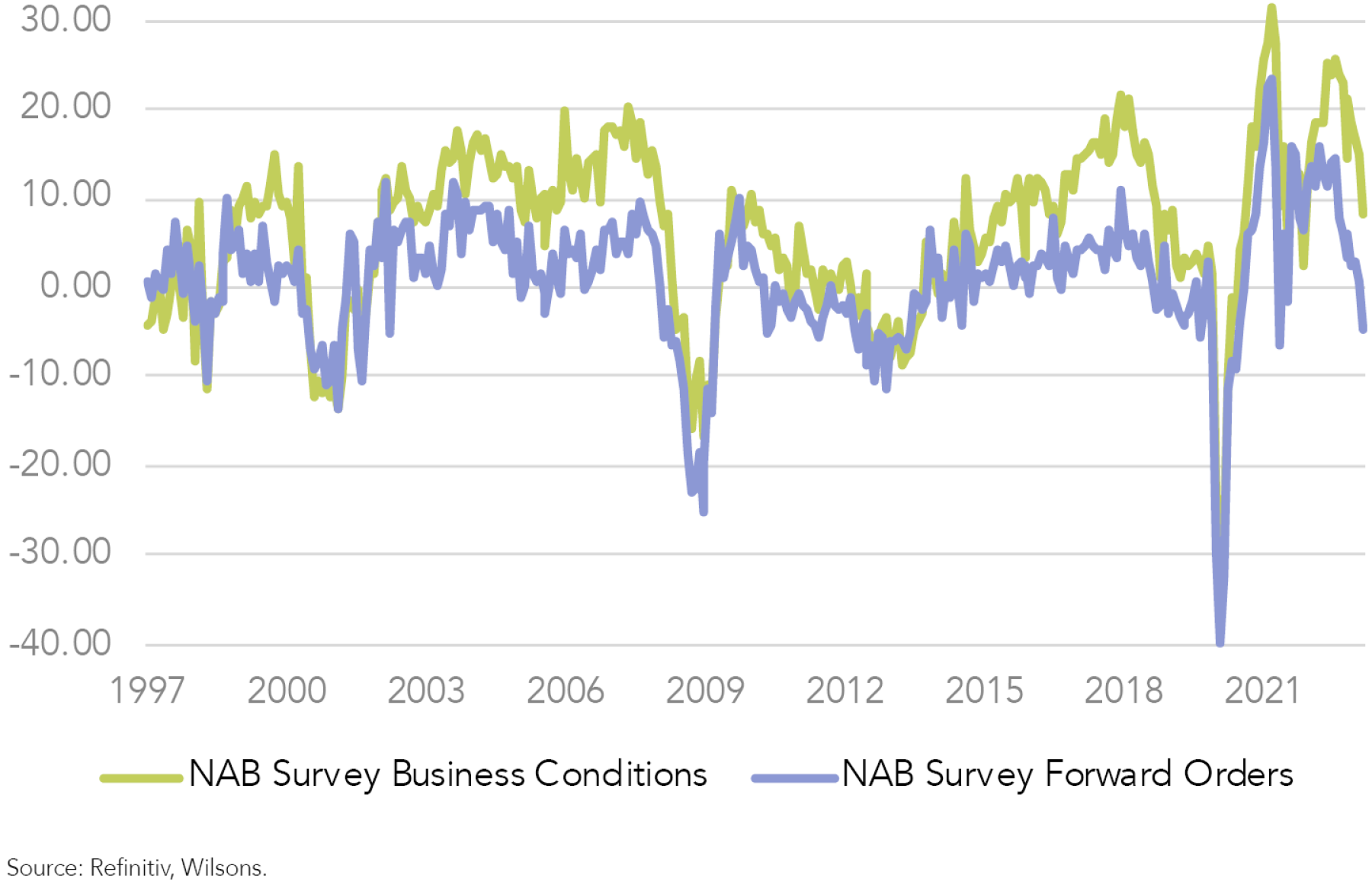
Figure 9: Key upcoming data releases
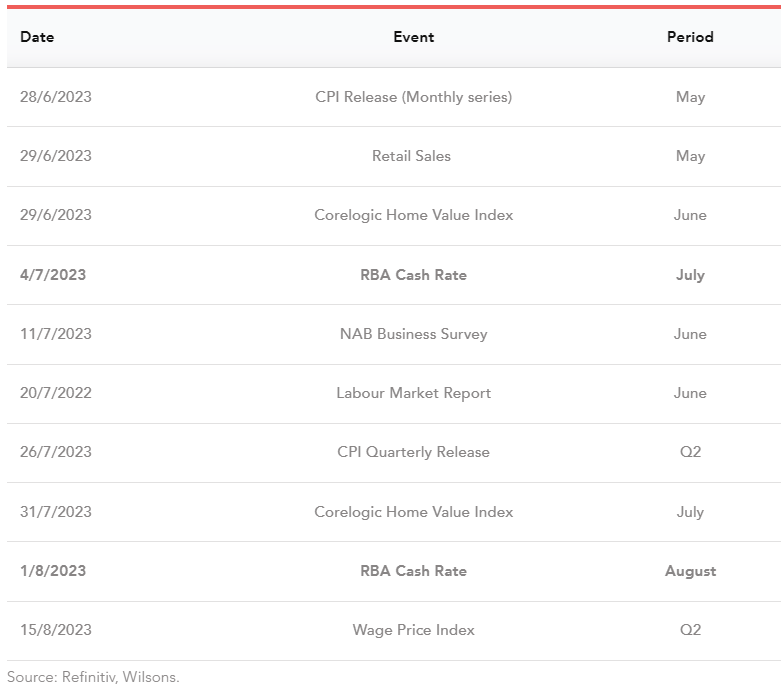
Navigating a Narrower Path
The Australian economy still has a degree of underlying resilience, as evidenced by ongoing labour market strength, strong migration flows and robust terms of trade position, so a recession is not our central case. However, risks of a policy misstep are rising and, by association, the rising risk of a significant slowdown, which was relatively low at the start of the year, is increasingly dragging on the Australian equity market.
The RBA's monetary policy decisions will be crucial in determining the path ahead, as they balance the need to address inflationary pressures while sustaining economic growth. The labour market remains tight, but inflation concerns persist. Consumer spending prospects face challenges, and business indicators point to a looming slowdown.
Although the case for believing the cash rate may have already peaked is weakening, the market expectation for a further 50bps of tightening feels overdone. We lean towards the view of limiting any further increase to 25bps, with the most likely timing being August, post the Q2 CPI release.
Australia’s sector mix and our belatedly hawkish central bank pose challenges for the performance of Australian shares, at least in the near term. The focus on resilient earnings should intensify in coming months as growth slows.
Domestic fixed interest looks increasingly attractive as a portfolio diversifier. Yields have edged up above our fair value area (~3.5%) with 10-year yields at 4%. With official cash rates above 4% and looking likely to push higher, high quality floating rate credit also represents an attractive source of income with yields above 5% on offer.
Learn more
WILSONS think differently and delve deeper to uncover a broad range of interesting investment opportunities for their clients. To read more of our latest research, visit our Research and Insights.

